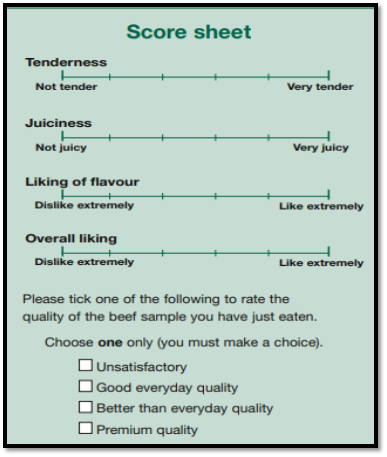
https://ec.europa.eu/eip/agriculture/en/find-connect/projects/bovine-beef-innovation-network-europe
Beef consumption is on the decline, and one reason is the variability in sensory quality even when the price is high. Furthermore, if consumers decide to eat less beef – for any other reason – this lower quantity should be compensated by high quality, including a guaranteed satisfactory eating experience, in order to keep them interested in buying beef. Therefore, it is necessary to know how different factors affect palatability in order to grade the meat and to facilitate improvement across the whole supply chain. Besides, farmers should be rewarded for providing beef of better quality according to the consumers’ wishes.
Within the beef industry, there are different carcass grading systems designed to add consistency and transparency; Europe uses the simplest one in the world: the SEUROP system. The voluntary Meat Standards Australia (MSA) system, on the other hand, is the most complex and the only one in which the cut and not the carcass is the grading unit and which takes into account post-chiller events such as ageing and the cooking method (grilled, roasted, baked, stir-fried, etc.), among other traits.
The grade is based on a predictive model of consumer satisfaction, supported by taste analysis wherein untrained consumers rate samples for their tenderness, juiciness, flavour, overall satisfaction, and quality grade under controlled conditions. With this information, the MSA has identified Critical Control Points (CCPs) in the production, pre-slaughter, processing, and value-adding aspects of the supply chain that impact consumer palatability. These CCPs are used as either (1) mandatory criteria to determine eligibility for grading or as (2) inputs in a model for predicting the palatability of individual combinations of muscle and different cooking methods.
 |  |
By statistical analysis with the data combined, a global quality score called MQ4 ranging from 0 to 100 is generated. When a certain threshold is reached they are MSA-graded into three categories which are easily understood by consumers: good everyday (3 *), better than everyday (4 *), and premium (5 *).
System advantages:
- Increased consumer satisfaction through the prediction of palatability
- Provides assurance for branded products
- Added value – Australian consumers are willing to pay more for MSA premium-quality beef
- The value of the carcass is calculated based on the eating quality and the volume produced, thereby delivering a financial reward for farmers producing high quality carcasses.
- The quality scale of MSA allows producers to realise the financial gain of incremental improvements in quality, as well as the precise economic weights associated with traits such as marbling, ossification score, or breed.
- Pricing is more transparent
- Producers can make informed decisions to modify both quality and yield traits
- Continuous improvement of the model
The MSA system is already a good practice in Australia, and research has been conducted in other countries where the system could work: France, Poland, Ireland, Northern Ireland, Japan, South Korea, New Zealand, the USA, and South Africa. However, the relative weighting coefficients for tenderness, flavour, juiciness, and overall satisfaction in the optimal calculation of the MQ4 score vary slightly between countries, and the optimal limits between quality classes can be refined for each country or for each group of consumers. One drawback of the system is the need for a large data set in order to be accurate.
Research on the application of the substantial amount of information gained using the MSA protocols in Europe and elsewhere will continue within the activities of the International Meat Research 3G Foundation. The Foundation was launched in 2017 under the auspices of the United Nations Economic Commission for Europe (UNECE). The Meat3G Foundation is likely to develop a new MSA-like model to predict eating quality of beef across countries and based on data gathered in various countries.
With its focus on improving eating quality, this system is mainly related to Production Efficiency and Meat Quality, but it also relates to the other three themes from BovINE.
 Source information:
Source information:
- Bonny et al. 2018. Journal of Integrative Agriculture 17(7): 1641–1654.
- Ellies-Oury et al. 2020. Various Statistical Approaches to Assess and Predict Carcass and Meat Quality Traits. Foods 9, 525.
- Photos from MSA website: https://www.mla.com.au/marketing-beef-and-lamb/meat-standards-australia/ and https://www.mla.com.au/globalassets/mla-corporate/marketing-beef-and-lamb/msa-beef-brochure_aus_lowres.pdf
Link to a video for more information:
- MSA Grading Beef: https://youtu.be/1-slgNKnCZs